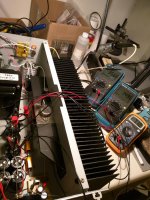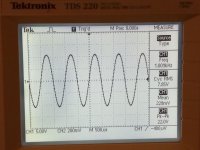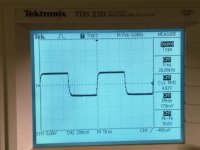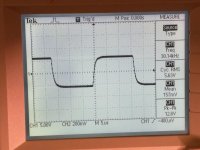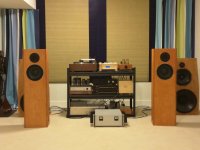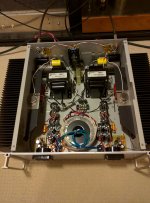I use a combination of big Russian PETP caps paralleled with "big" polyestyrene, all army surplus caps, which are cheap at eBay. Best extension and trasparency, after burn-in.
Cheers,
M.
Cheers,
M.
2sk180
I have the right channel up running for about 90 minutes now. The temperature on 180 39c and the180 metal base 34c. There is only 30 c on the L bracket, the heat sink is not hot at all.
I have 35.6v Vd, 1.47A Id at -7.1v bias. Are all the numbers at the range?
I have the right channel up running for about 90 minutes now. The temperature on 180 39c and the180 metal base 34c. There is only 30 c on the L bracket, the heat sink is not hot at all.
I have 35.6v Vd, 1.47A Id at -7.1v bias. Are all the numbers at the range?
Attachments
I have the right channel up running for about 90 minutes now. The temperature on 180 39c and the180 metal base 34c. There is only 30 c on the L bracket, the heat sink is not hot at all.
I have 35.6v Vd, 1.47A Id at -7.1v bias. Are all the numbers at the range?
Good progress 🙂
You may tune the operating conditions either by ears, or by a sound card based distortion analyzer (most onboard sound cards will do, you don't need -100dB sensitivity for the L'Amp), but make sure you step down the output signal before feeding the sound card.
One alternative here:This would be a controversial subject, but I would like to hear how you guys choose output DC blocking capacitor.
It seems like even Mr. Pass is bypassing Electrolytic with film on his SIT amps, so I guess the choice of the capacitor would make some considerable difference in sound, but I don't know how to choose the right ones. Probably, computer grade ultra low ESR bypassed with huge fancy film would be ideal, but since I follow Mr. Pass's philosophy, I'm trying to avoid using "too-fancy" audiophile parts as much as possible. So I would like to know what numbers (ESR, voltage, film cap size, etc) should I concern.
http://www.diyaudio.com/forums/solid-state/220222-nognfb-integrated-amp-ge-transistors-output-3.html see posts 25, 28 and 30
In post #25 ilimzn suggests bipolar caps. Only this month, after so much time, I'm back to Ge project and experiment with it. I'm experimenting with bipolar alternative and have a good impression of it; mundane bipolar cap seems to be more clean sounding than mundane polar cap. I'm not into a "cap craze" but some subtle thing occurs in sound perception related with them, and not so subtle if cap is underrated for bass.
Thank you guys,
A lot of very interesting (never heard of) ideas, motor cap and paralleling bipolar with resistor.
It is good to know that paralleling electrolytic can be possible for output, since as gregchristie had suggested, the value of output cap will affect the high pass filter Q when choke loaded, so I was struggling how to determine the right value without buying too many different values of electrolytic.
A lot of very interesting (never heard of) ideas, motor cap and paralleling bipolar with resistor.
It is good to know that paralleling electrolytic can be possible for output, since as gregchristie had suggested, the value of output cap will affect the high pass filter Q when choke loaded, so I was struggling how to determine the right value without buying too many different values of electrolytic.
Thanks so much for good suggestions and advices.
I tried to make the amp to the voltage that Mike sim for me a while back. I used whatever I have on hand and switched the psu to CRCRC configuration. I have now 34v Vd at 1.4A Id. Can't make 34v at 1.25A for I lowered the Id, the Vd went higher.
I have some good square wave with this. I never finished an amp with so good the highs, but the lows are inferior to the F6.
I tried to make the amp to the voltage that Mike sim for me a while back. I used whatever I have on hand and switched the psu to CRCRC configuration. I have now 34v Vd at 1.4A Id. Can't make 34v at 1.25A for I lowered the Id, the Vd went higher.
I have some good square wave with this. I never finished an amp with so good the highs, but the lows are inferior to the F6.
Attachments
Eh....One more thing, I have the amp on for about 4 hours last night. Everything stable but the temperature on top of 180 was only 41c, on base 37c and only 34c on heat sink the part close to the 180, the other location was around 30c. Is it normal? Or my heat sink too big?
Just a heads up I found some super deals on Amazon for some polypropylene motor start motor run caps. I bought a couple just to find out not only were they just electrolytic but an extremely low quality electrolytic. Well I should have known better.
Eh....One more thing, I have the amp on for about 4 hours last night. Everything stable but the temperature on top of 180 was only 41c, on base 37c and only 34c on heat sink the part close to the 180, the other location was around 30c. Is it normal? Or my heat sink too big?
It's an issue only when your heat sink is too small, not when it's too big 🙂
It's an issue only when your heat sink is too small, not when it's too big 🙂
Didn't Papa say there's no such thing as too much heatsink? 🙂
It's pretty remarkable how cool the SIT is running considering it's
dissipating close to 50W. Very nice...
Cheers,
Dennis
use what Nelson is using
and just slab big honkin' motor run cap in parallel
say 30-50uF
this side of Big Splash , we have Icar and Ducati
on your side there is GE and ....... you probably know
I believe in info that substantial number of Audiofool grade caps are nothing else than beautified motor-run caps
Is this true? Interesting if it is.
Could you make a non-polarized cap by connecting ++ together? It would halve the value, correct?
Vince
It's an issue only when your heat sink is too small, not when it's too big 🙂
Tim,
Big thanks for your support and the amp is singing for me now. It sounds wonderful, not like the SS amps I built. I'll post some more pictures and comments after I squeeze all juice out from it. I've ordered some caps to try on the output. See what will happen. I have 10000 with 15 motor run at the moment.
Albert
Attachments
Last edited:
Yes you can make one, but will continue to be a polar cap (albeit with different 2H vs 3H order distortion generation), and not a film cap or even a bipolar electrolytic cap. The motor run cap is a genuine film cap, not to be confused to a motor start cap, generally a electrolytic bipolar device with bigger capacitance.Is this true? Interesting if it is.
Could you make a non-polarized cap by connecting ++ together? It would halve the value, correct?
Vince
I used 6x Nichicon 1000µF "genuine" bipolar caps in my "bipolar experiment" tests because motor start caps have so low capacitance or big size. I not bypassed them with film caps, but people fell free to experiment.
Yes you can make one, but will continue to be a polar cap (albeit with different 2H vs 3H order distortion generation), and not a film cap or even a bipolar electrolytic cap. The motor run cap is a genuine film cap, not to be confused to a motor start cap, generally a electrolytic bipolar device with bigger capacitance.
I used 6x Nichicon 1000µF "genuine" bipolar caps in my "bipolar experiment" tests because motor start caps have so low capacitance or big size. I not bypassed them with film caps, but people fell free to experiment.
The problem of distortion has to do with the need for electrolytics to be properly biased by a DC voltage. This does not happen when they are 'back to back' unless a supply and a high resistance is available for biasing the ++ connection. Fortunately such is usually not that hard to find 🙂
If properly biased, electrolytics can give performance very close to that of film caps. This is why they work in cathode bypass applications.
Yes you can make one, but will continue to be a polar cap (albeit with different 2H vs 3H order distortion generation), and not a film cap or even a bipolar electrolytic cap. The motor run cap is a genuine film cap, not to be confused to a motor start cap, generally a electrolytic bipolar device with bigger capacitance.
I used 6x Nichicon 1000µF "genuine" bipolar caps in my "bipolar experiment" tests because motor start caps have so low capacitance or big size. I not bypassed them with film caps, but people fell free to experiment.
I'm curious about the result of your 6x Bipolar Experiment. Did you notice any difference from the conventional Electrolytic + Film?
I only compared with a array of 6x MUSE polar types and also versus an old Siemens ~15000µF computer grade and for my ears the bipolar seems to be a tad cleaner, but be aware that in some different system/ears, the results maybe reverse. I'm not compared with a parallel film cap yet but since I compared "oranges with oranges" (different electrolytic constructions/forming), one can add a film cap to every option (or to the champion option) if desired.
2sk180
I've been trying different output caps combination and now I settle on 10,000uf parallel with 100uf motor run and 10uf Auricap. 8.2uf Jensen supreme with 1uf oil at input . It sounds gorgeous with my system with delicate highs and lush mids. I love this amp more now. ����
I've been trying different output caps combination and now I settle on 10,000uf parallel with 100uf motor run and 10uf Auricap. 8.2uf Jensen supreme with 1uf oil at input . It sounds gorgeous with my system with delicate highs and lush mids. I love this amp more now. ����
Attachments
- Home
- Amplifiers
- Pass Labs
- L'Amp: A simple SIT Amp
